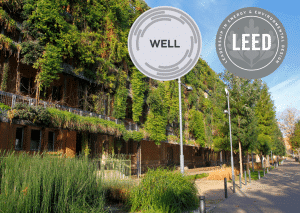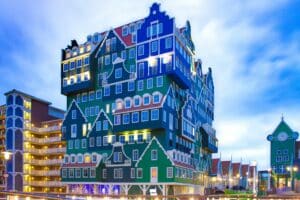We are presently living in a time when future looks uncertain. With coronavirus spreading across the world and no cure in sight as of now, we no longer know what the future has in store for mankind. Public gatherings have been banned, schools and universities are closed, businesses are shut, global economy is in shambles, countries are tapping emergency public funds, and we, humans, are shut in our homes.
These are certainly unprecedented times. This pandemic has impacted the way we live and work. It has got people talking about the way we have designed our homes and office buildings and how in some places, this is aiding the spread of the virus further.
It is not just about the hygiene and super clean indoors that, in any case, is non-negotiable and must happen under the current circumstances. But the virus is also stoking conversation on the need for designing of living spaces that allow adequate ventilation and sunlight for healthy living to contain the problem.
If you look at the antiquated photographs of Spanish flu circulating nowadays in social media, they show sun bathing and fresh air as methods for cure. So it is very important to have buildings that allow good ventilation, sunlight and open spaces for healthy living to prevent health complications when viruses are set loose.
As in the case of all major public health emergencies, prevention and control are the most important elements to overcome the problem. Coronavirus has forced people to stay indoors. Therefore, buildings are playing a significant role in preventing the spread of this virus.
Community and building-based prevention and control measures have become one of the most important methods of fighting against the pandemic. These include self-isolation, community management, elevator disinfection, environmental cleaning, open windows for natural ventilation, etc.
What is Coronavirus and how does it spread?
Coronavirus belongs to a family of viruses that affect the respiratory tract and cause a range of illnesses—from a mild cold, to a serious case of pneumonia. COVID-19 is a disease caused by a new viral strain of the coronavirus, not previously seen in humans. While health officials are still learning more about how the virus spreads and ways to control the outbreak, according to the US Centers for Disease Control and Prevention, COVID-19 can be spread in three main ways, with the first two suspected to be the most common:
- Person-to-person via direct contact.
- Person-to-person via airborne respiratory droplets produced when an infected person coughs or sneezes.
- Surface-to-person via contact with surfaces or objects that hold the virus, followed by an individual touching their own mouth, nose, or eyes.
It is believed that people are most contagious when they are symptomatic, though it is possible to spread the virus before symptoms are shown. It is important to note that more than 80% of confirmed coronavirus cases are not severe and do not require hospitalization. Vulnerable populations, such as the elderly and those with underlying health conditions, are at greater risk for infection and severity of symptoms
Also Read: Coronavirus and Building Wellness: Tips to Optimize Building for Covid-19 Prevention
What is a green building?
In simple terms, a ‘green’ building is a building that minimizes or eliminates negative aspects and has the ability to create positive impacts on our natural environment through its design, construction and operation. Almost all green buildings are sustainable, preserve precious natural resources and improve our quality of life.
Further Reading: Green Building Rating System – A Complete Guide
There are seven main components of green building:
1. Energy Efficiency
Energy efficiency is the key to making a building a finely tuned, lean, green machine. A green building design takes maximum advantage of the sun and wind to heat, light, and cool the building affordably.
2. Water Efficiency
To conserve finite freshwater resources and reduce utility bills, green buildings install water-efficient appliances and plumbing fixtures, feature landscaping with drought-resistant plants and efficient irrigation, and put rainwater and gray-water to use.
3. Green, sustainable Materials
Green, high quality building materials that minimize or eliminate indoor air quality concerns, avoid toxins, and greatly reduce waste are now widely available, often from local manufacturers. Recycled-content and pre-fabricated products reduce material use, cut costs, and often perform better than traditional alternatives.
4. Waste Reduction
Green buildings reduce, reuse, and recycle construction and demolition waste to cut costs and improve building quality. They are designed for efficient use of materials and for durability, avoiding future waste. With the right setup, you can recycle over 70 percent of some waste materials on the construction site, and residents can recycle 100 percent of others in their homes.
5. Indoor Air Quality
Indoor air quality significantly impacts resident health and comfort – these are essential goals for any building. Achieving a high quality indoor environment requires careful design, construction, and materials choices, and thus strong coordination among the building team. Indoor air quality centers on well-designed ventilation and moisture control, which goes hand in hand with energy efficiency and building durability. Ongoing maintenance is important, of course, as is a commitment to finding alternatives to toxic materials and finishes.
6. Community
Green buildings and developments support strong communities by giving neighbors places to meet, establishing a sense of place and safety, and creating spaces for pedestrians and kids, rather than cars. Successful and sustainable designs involve residents and community members from the planning stage all the way through to operation and maintenance.
7. Commissioning
Commissioning is the process of making sure that a building works right. By systematically evaluating and adjusting building systems to function together as designed, commissioning optimizes efficiency, health, and comfort.
How can green buildings help in the fight against COVID-19?
There is no doubt about the fact that a green building can help its inhabitants cope better with public health emergencies. The following points demonstrate how green buildings can help people in the prevention and control of COVID-19:
Increased Ventilation
In most of our buildings, air is recirculated which increases the chances of the virus getting trapped in the air vents of air conditioning systems. Therefore, ventilating a building with outdoor air is vital to dilute airborne contaminants and decrease disease transmission rates. All green buildings are well ventilated, which helps a lot in preventing the spread of the virus.
Provide basic functions for epidemic prevention and control
Apart from good ventilation, green buildings put a lot of emphasis on indoor disinfection and cleaning, which is a must in the time of coronavirus crisis. Several measures like avoiding gatherings, proper waste management, spreading awareness, information management, improved air quality and water quality monitoring can be undertaken to help people cope better with the current situation.
Reduce the risk of infection
In addition to providing the basic functions and convenient conditions for epidemic prevention and control, a green building itself should also “isolate” the virus as much as possible to reduce the risk of infection. Green buildings can do this by controlling the collusion of air and pollutants; controlling the exhaust backflow of kitchens and bathrooms; setting up effective water seals to reduce the risk of virus transmission through drainage pipes and stools; controlling the concentration of indoor particulate matter; optimizing the building space and plane layout to enhance the effectiveness of natural ventilation; controlling air conditioning system by zones; and well-designed site wind environment for dissipation of viruses and harmful gases.
Boost the health and immunity of its inhabitants
In this time of crisis, people are stressed and fearful. We need nature now more than ever. Green buildings often rely on benefits of plants to create a healthy environment. According to a research, offices experience a 15% increase in productivity when plants are included in office space. Employees with plant views have fewer headaches and complete concentration tests 19% faster than those without plants. Also, green buildings use environment-friendly materials to reduce the concentration of indoor air pollutants such as ammonia, formaldehyde, benzene etc. to boost the health of its inhabitants.
Provide convenience and facilities for epidemic prevention and control
Providing convenience and facilities for epidemic prevention and control are the basic guarantee for the orderly progress in epidemic prevention and control. In this regard, green buildings can enable buildings occupants and site workers to provide quick access to medical equipment and facilities; offer effective personnel and vehicle control; provide conditions to add relevant signs to alert people; and change the room function when necessary (medical rooms, transitional residential rooms, isolation and observation rooms, supplies storage rooms, etc.).
It goes without saying that healthy buildings play a central role in creating a healthy world. In addition to everyday precautions taken by individuals, the building industry and employers have a vital role to play in creating safe environments for themselves and their employees.
COVID-19 has taken a major toll on global economies due to production halts, strained healthcare systems, supply chain disruptions, workplace and school closures, and event cancellations. Taking measures to build a healthy environment is prudent to both preventing illness and preventing loss of productivity.
With inputs from:
https://www.worldgbc.org/news-media/contribution-green-buildings-fight-against-covid-19
https://centerforactivedesign.org/5-ways-to-optimize-buildings









